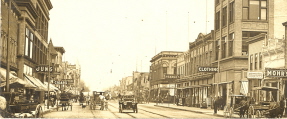SHEBOYGAN HISTORY

SHEBOYGAN HISTORY |
 |
|
| Home | Yearbooks | Students | Biographies | History | Phone Books | Churches | Pictures | Links | ||
Philip Meyer, Page 564
PHILIP MEYER, deceased, is well deserving of mention among the honest, hard-working men who have built up the manufacturing interests of Sheboygan, and thus laid the foundation for the city's growth and fame. The above-named gentleman was born in Doerrebath, Kreuznach, Rhenish Prussia, Germany, May 21, 1829. He is a half-brother of Jacob J. Vollrath, in whose sketch will be found a fuller account of their parents. Mr. Meyer received his education in the German language, but after coming to the United States became well acquainted with the English. In his native land he learned the moulder's trade, by means of which he made his financial start. In 1845 he accompanied his parents to the United States, and after working a year at Albany, N. Y., the family came on to Milwaukee County, Wis., and located on a farm. Having helped to improve and make a home for his parents, Mr. Meyer Pursued his trade both in Milwaukee and Chicago. In the latter city he was married, April 17, 1853, to Miss Wilhelmine Barnieck, a native of Brandenburg, Germany, born February 27, 1833. When a small child she lost her mother, after which her father, Jacob Barnieck, was again married. In 1850, Mrs. Meyer came with them to America, and located near Milwaukee. Mr. Barnieck was in comfortable circumstances in Germany, but lost his money after coming to this country, by lending it to irresponsible parties. Having the utmost confidence in his fellow-man, he learned, by sad experience, when it was too late, the truthfulness of the old saying, "White men are uncertain." Both he and his wife died near Milwaukee, leaving a family of five children, two sons and three daughters. Mrs. Meyer is the only child of the first marriage. She and her husband began their domestic life in Chicago, where they lived until 1854, which year witnessed their arrival in Sheboygan. For a time Mr. Meyer worked for his half-brother, J. J. Vollrath, and for others, and with his savings built him a small house. He, Albert Schmidt and Henry Foeste were the head workmen in the old Globe Foundry, and when the foundry burned these three gentlemen decided to purchase what was left of it, and go into business for themselves. Mr. Foeste was fortunate enough to have some money, but the other two, in order to raise their part of the means, had to sell their little homes. They began business on a very limited scale, but being good workmen and industrious, the business prospered from the start. This co-partnership lasted for eleven years, when Mr. Foeste became sole proprietor. A year later, however, Mr. Meyer was induced to take a half-interest in the business, which was run by these two gentlemen for eight years. Again, Mr. Foeste became the proprietor of the establishment, but having kept it about two months, he sold to Mr. Meyer and William Schrage, the firm being Meyer & Schrage. In 1891 the former purchased the interest of his partner. Two years later, on the 13th of March, Mr. Meyer passed from among the living, willing his valuable estate to his widow. In April following the business was incorporated under the style of The Philip Meyer Company, with the following officers: Mrs. Wilhelmine Meyer, President; August Ortmeier, Secretary and Treasurer; William Meyer, Superintendent. The plant is located at No. 826 Pennsylvania Avenue, where an extensive and prosperous business is carried out. Unto Mr. and Mrs. Meyer were born six children: Matilda, who is the wife of August Ortmeier; Minnie, who married Paul Klumb, of Appleton, Wis.; John, who resides in Sheboygan; Lydia, who is the wife of Joseph Koerner, of the same city; Sarah, who became the wife of William le Blond, a plumber of Sheboygan, and William, who is superintendent of the foundry, completes the family. Mr. and Mrs. Meyer were among the original members of the first German Reformed Church established in Sheboygan. Side by side they toiled up the rugged hill of life for nearly forty years, toiling, sorrowing and rejoicing. When they began their domestic life they were not worth five dollars; in truth, they had to borrow the money with which they paid for the first little cook stove. The husband was honest and hardworking; the wife was also industrious and frugal. By their united efforts they accumulated valuable property for their children, but, better than all, they set them an example of right living worthy to be imitated.
|
||
| Copyright © 2009 www.sheboyganhistory.com - All Rights Reserved. |